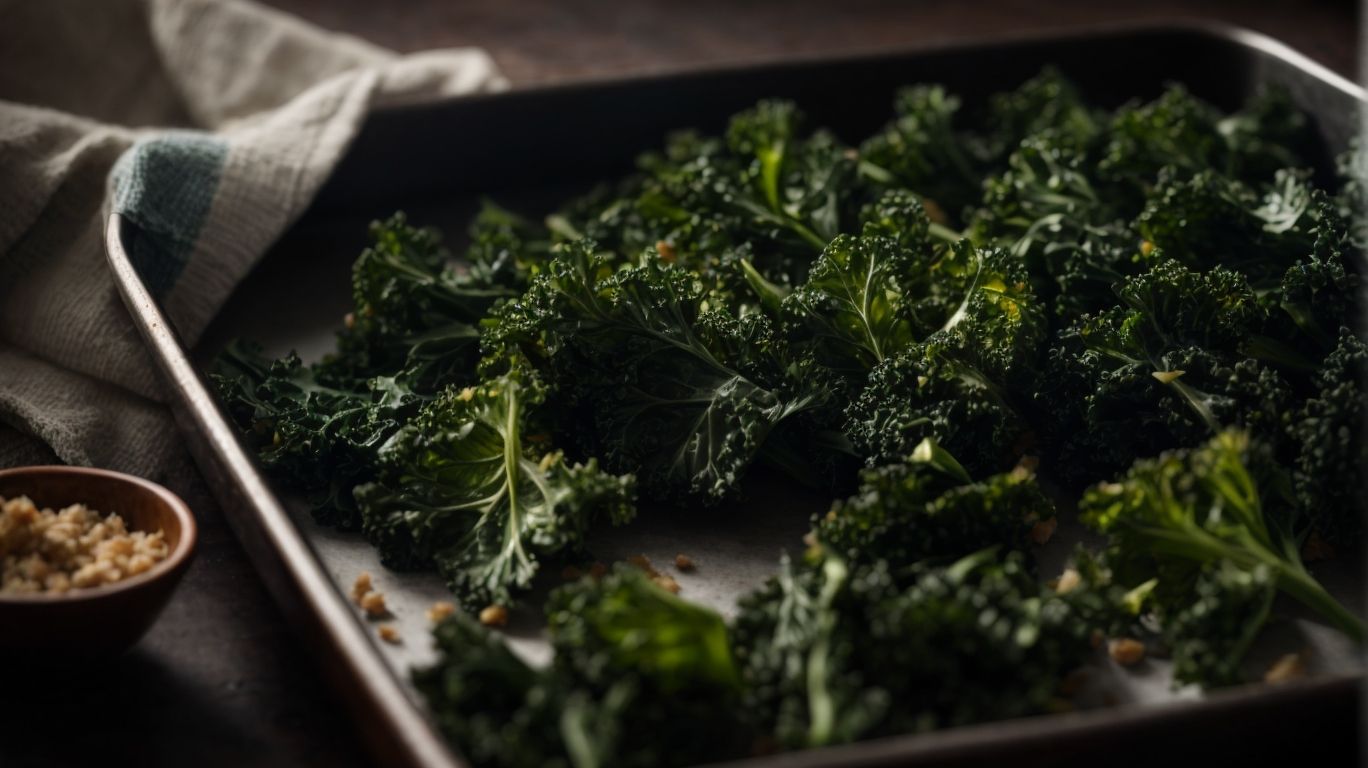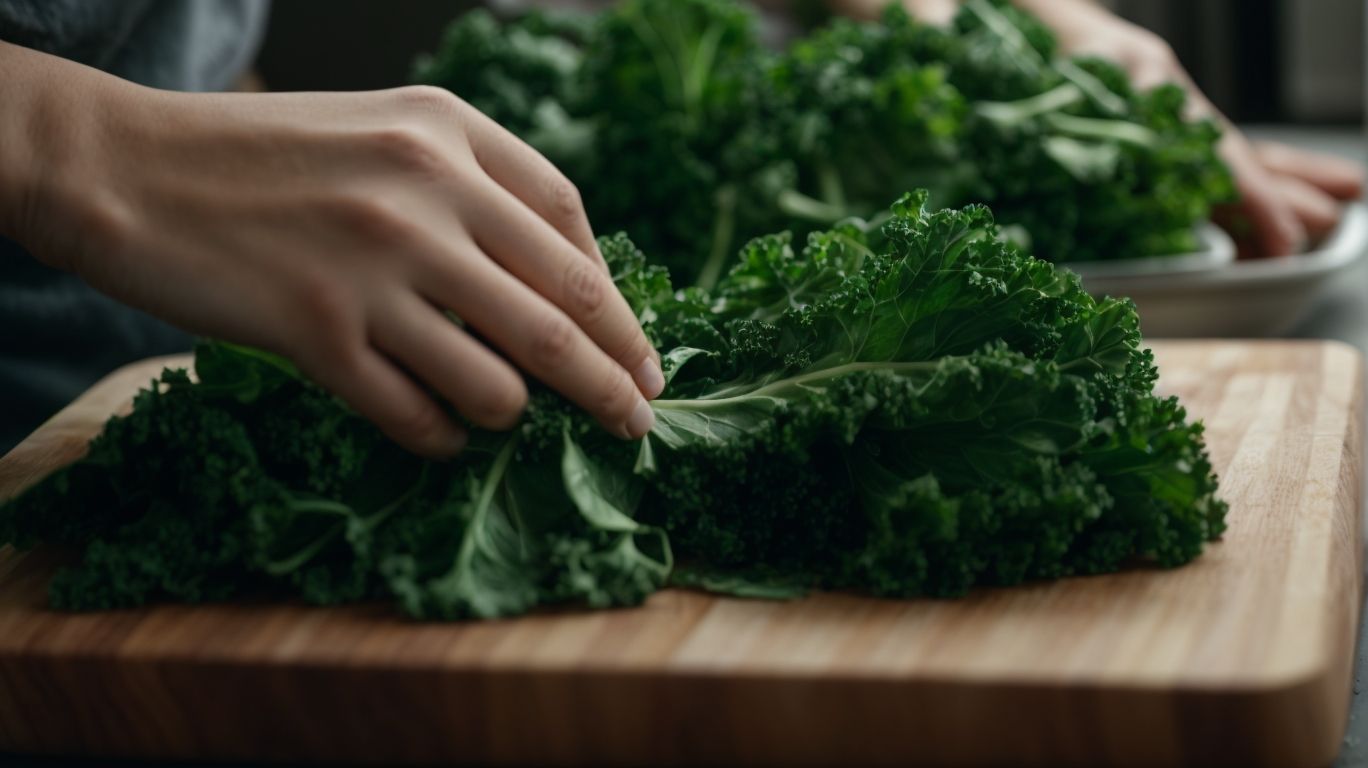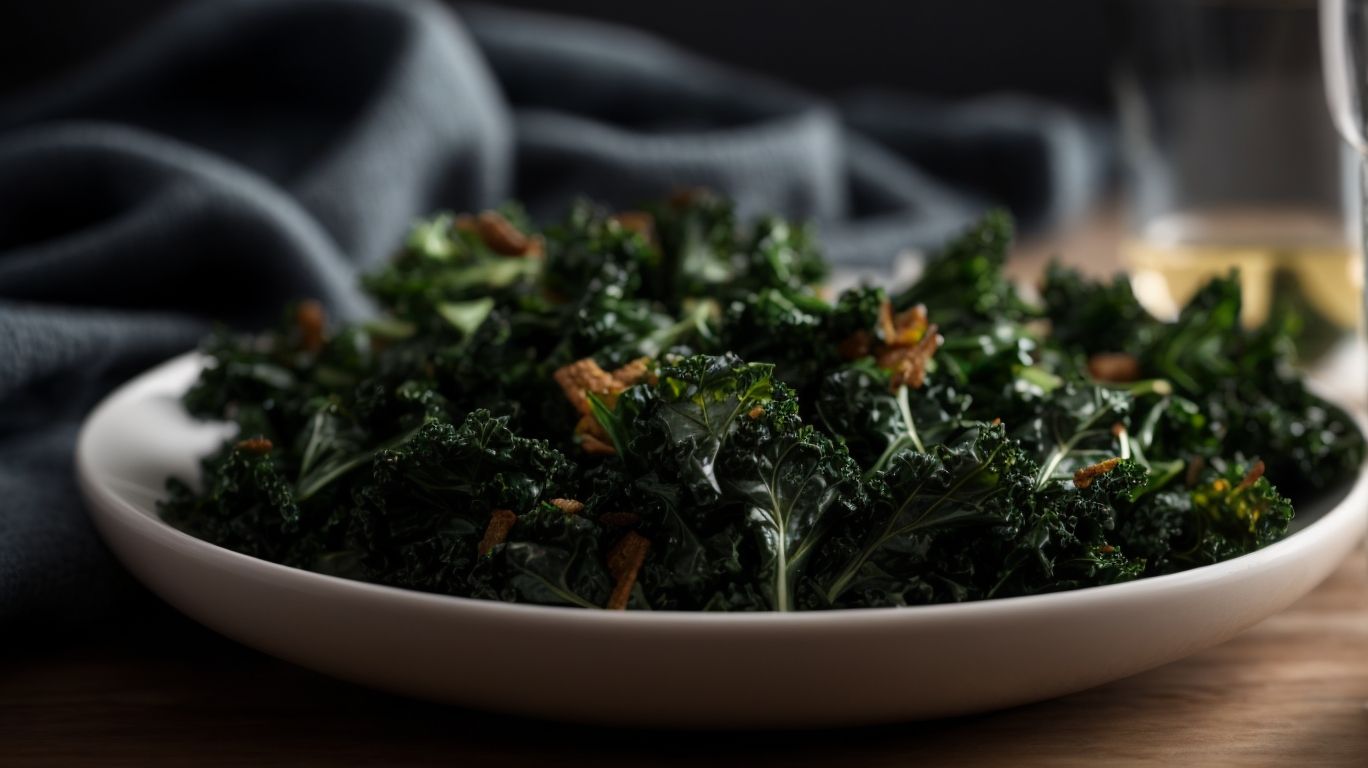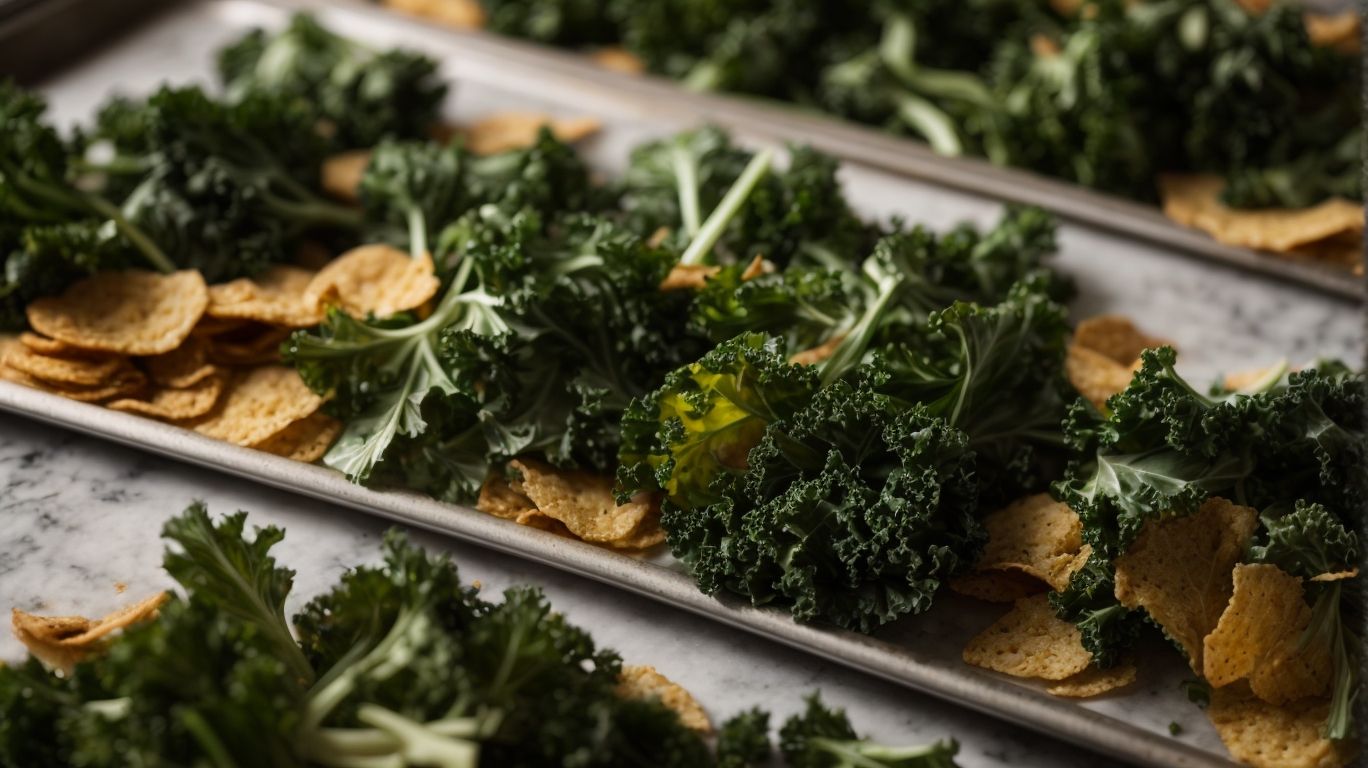How to Bake Kale?
If you’re looking to add a nutritious and tasty snack to your repertoire, baking kale may be just the thing for you.
In this article, we will explore the health benefits of this leafy green, its versatility in recipes, and how to prepare and bake kale to perfection.
From choosing the right kale to seasoning options and creative recipes, we will cover everything you need to know to create delicious baked kale dishes.
Let’s get started on this journey to crispy and flavorful goodness!
Key Takeaways:
Why Bake Kale?

Credits: Poormet.Com – Steven Nguyen
Baking kale offers a delicious and nutritious way to enjoy this leafy green vegetable. Whether one is in search of a crispy snack or a flavorful side dish, baked kale is a versatile option that can be easily customized to suit taste preferences.
One of the fantastic aspects of baked kale is the crispy texture it acquires when baked to perfection. The transformation from simple leafy greens to crispy, flavorful chips is a game changer in the snacking realm. Baking kale at home gives you the control over ingredients, ensuring a healthier alternative to store-bought snacks. This easy cooking process involves simply tossing kale leaves in a bit of olive oil, seasoning them with salt, pepper, or any spices you desire, and then baking until crunchy.
Health Benefits
Baking kale not only enhances its flavor and texture but also preserves its nutritional value. Kale is packed with essential nutrients like protein, fiber, and vitamins, making it a healthy addition to your diet.
One of the standout features of kale is its high vitamin C content, which supports the immune system and acts as a powerful antioxidant. Its abundance of vitamin K is essential for bone health and blood clotting.
Kale is a great source of minerals such as iron and calcium, crucial for energy production and strong bones. The fiber content in kale aids digestion and promotes gut health.
Rich in nutrients and low in calories, kale is a superfood that can help in weight management and overall well-being. Whether consumed raw in salads, sautéed, or baked into crispy chips, kale offers a versatile and nutritious option for any meal.
Versatility in Recipes
One of the key reasons to bake kale is its versatility in recipes, allowing you to experiment with different flavors, ingredients, and cooking techniques. From simple seasonings to complex marinades, kale can be transformed into a culinary delight with the right tips and tricks.
For a delightful light snack, crisp kale chips can be easily made by tossing kale leaves with olive oil, sea salt, and a sprinkle of nutritional yeast for a cheesy flavor before baking until crispy.
On the other hand, if you’re looking to add kale to hearty main dishes, consider incorporating it into a flavorful lasagna where the earthy taste of kale complements the richness of a creamy ricotta and tangy tomato sauce.
Preparing Kale for Baking

Credits: Poormet.Com – Aaron Roberts
Before you can start baking kale, it’s crucial to select the right type of kale and ensure it is properly cleaned and dried.
Curly kale, with its frilly leaves, offers a robust flavor and holds up well in baking, while lacinato kale, also known as dinosaur kale, boasts a slightly sweeter taste.
When choosing kale, opt for organic varieties for better nutritional value. After selecting your preferred type, it’s essential to wash the kale thoroughly to remove any dirt or residue. Rinsing the leaves under running water and patting them dry with a clean kitchen towel helps achieve the desired crispness when baking.
Choosing the Right Kale
Selecting the freshest kale from reputable brands like Whole Foods or local producers ensures that your baked kale turns out flavorful and nutritious. Consider opting for organic or locally sourced kale for an added touch of freshness and sustainability.
When choosing high-quality kale, look for leaves that are deep green in color, free from wilting or yellowing. Inspect the stems; they should be firm and vibrant, indicating freshness. Consider checking out Farm Fresh Organics or Local Greens Delivery for a sustainable and convenient option. Organic kale is free from harmful pesticides and synthetic fertilizers, offering a cleaner and more nutrient-dense choice. Sourcing locally supports the community and reduces carbon footprint.
Cleaning and Drying Kale
After selecting your kale, it’s essential to clean and thoroughly dry the leaves to ensure optimal crispiness when baked. Proper storage techniques and attention to detail during the cleaning process can enhance the overall quality of your homemade kale chips.
Begin by washing your kale leaves under cold running water to remove any dirt or debris. To effectively clean kale, you can immerse the leaves in a bowl of water and gently swish them around. After washing, thoroughly drying the kale is crucial to prevent sogginess. Use a salad spinner or pat the leaves dry with a clean kitchen towel to remove excess moisture. Once the kale is clean and dry, store it properly to maintain its freshness.
Basic Steps for Baking Kale
In terms of baking kale, following a few simple steps can lead to crunchy and delicious results. From preheating the oven to tossing the kale in oil and seasonings, understanding the basic baking process is key to achieving the perfect texture and flavor.
After seasoning the kale, spread it out in a single layer on a baking sheet lined with parchment paper to ensure even cooking. Place the sheet in the preheated oven and bake for about 10-15 minutes, turning the kale halfway through to promote even crispiness.
For an extra crunch, consider adding a sprinkle of sea salt or a dash of chili flakes before baking. Once the kale is crispy and slightly browned, remove it from the oven and let it cool for a few minutes before serving.
Preheating the Oven
Before you begin baking kale, ensure that your oven is preheated to the recommended temperature for optimal results. Consistent heat distribution is essential for achieving crispy kale chips that are evenly cooked and full of flavor.
Proper preheating also helps in preventing the kale from becoming soggy or burnt, resulting in a perfect texture with a delightful crunch.
During seasonal events and deals, like the holiday season or farmer’s markets showcasing fresh produce, baking kale can be a great way to incorporate local flavors into your dishes, adding a touch of regional authenticity to your meals.
Tossing Kale in Oil and Seasonings
Coating the kale leaves evenly with olive oil and a mix of seasonings is essential for creating a crunchy, flavorful, and healthy snack. The right balance of ingredients ensures that each bite of baked kale is packed with deliciousness and nutritional goodness.
Once the kale leaves are thoroughly coated in olive oil, it’s time to add the seasonings. This step is where you can get creative, adding a sprinkle of sea salt for that perfect savory element, a dash of garlic powder for depth of flavor, and a hint of red pepper flakes for a touch of heat. Mixing these seasonings together before tossing them with the kale ensures even distribution and enhances the overall taste.
Baking Time and Temperature
Determining the right baking time and temperature is crucial for achieving the desired texture and flavors in your baked kale. Whether you prefer a slightly softer chip or a more crispy finish, following trusted recipes and guidelines can help you achieve the perfect result every time.
In terms of baking kale chips, a common range for temperature is around 275°F to 325°F. At these temperatures, the kale leaves crisp up beautifully without burning. The baking time typically varies between 10 to 20 minutes, depending on your oven and the desired crispness level. For a deeply savory flavor, consider sprinkling some Parmesan cheese or nutritional yeast before baking. To add a spicy kick, a dash of cayenne pepper or smoked paprika can elevate the taste profile. Experiment with different seasonings like garlic powder, onion powder, or even a drizzle of balsamic glaze once the chips are out of the oven.
Flavoring and Seasoning Options
Exploring different flavoring and seasoning options can elevate the taste of your baked kale to new heights.
From classic pairings like garlic and Parmesan to more adventurous combinations such as sriracha and honey, experimenting with different flavors can add depth and excitement to your kale chips.
When selecting your seasonings, consider balancing bold flavors like cayenne pepper with milder ones like nutritional yeast for a well-rounded taste profile.
For textural contrast, try adding crunchy elements like toasted sesame seeds or pine nuts to your kale before baking.
Simple Salt and Pepper
For a quick and easy seasoning option, you can’t go wrong with a sprinkle of salt and pepper on your baked kale. This classic combination enhances the natural flavors of the kale while adding a subtle savory kick to each crispy bite.
When using salt and pepper on baked kale, it’s important to strike the right balance to elevate the dish. Too much salt can overpower the kale’s inherent earthy taste, while too little can leave the dish lacking flavor. The salt helps to enhance the kale’s sweetness and counterbalance its slight bitterness, while the pepper adds a hint of heat and complexity.
Experiment with different variations to find your perfect seasoning ratio. For a twist, try adding a dash of garlic powder or a sprinkle of parmesan cheese to complement the salt and pepper. Keep in mind that freshly ground black pepper can bring a more vibrant and robust flavor than pre-ground pepper.
Adding Spices and Herbs
Infusing your baked kale with aromatic spices like garlic and earthy herbs like sesame seeds can take your snack to the next level. These flavorful additions not only enhance the taste of the kale but also offer unique aroma profiles that tantalize the senses.
When preparing your baked kale, consider experimenting with smoked paprika for a hint of smokiness or cayenne pepper for a spicy kick. Combining cumin and coriander can bring a warm and earthy undertone to the dish, complementing the natural flavors of the kale.
To preserve the freshness and potency of the seasonings, store them in airtight containers away from direct sunlight and moisture. Labeling and dating your spice jars can help you track their expiration dates, ensuring you use them when they are at their peak.
Sweet and Savory Combinations
Experimenting with sweet and savory combinations for baked kale can yield surprising and delightful results. Whether you opt for a honey-glazed finish or a tangy balsamic drizzle, these creative pairings add depth to the flavors and offer a unique twist to your kale chips.
By incorporating ingredients like maple syrup, nuts, or cayenne pepper into your baked kale recipe, you can create an array of exciting taste sensations. The protein-rich nature of kale makes it ideal for guilt-free snacking, ensuring that your cravings are satisfied while keeping calorie counts in check. Consider serving your baked kale chips alongside a creamy avocado dip or a spicy hummus for a delightful contrast of textures and flavors.
Creative Recipes for Baked Kale
Beyond the traditional kale chips, there are numerous creative recipes that feature baked kale as a star ingredient. From a crunchy kale caesar salad to a savory kale and mushroom quiche, the culinary possibilities with baked kale are endless and delicious.
For a lighter option, consider a kale and mango salad with a zesty citrus dressing, offering a refreshing and nutritious dish. Alternatively, indulge in a hearty kale and feta stuffed chicken breast, showcasing the kale’s ability to enhance both flavor and texture in a diverse range of recipes.
The rich umami flavors of baked kale can be savored in a creamy kale and bacon macaroni and cheese, elevating the classic comfort food to a whole new level of sophistication. Incorporating baked kale into these dishes not only adds a nutritional boost but also provides a unique and tantalizing twist to familiar favorites.
Kale Chips
Kale chips are a classic and beloved snack that combines the crunchiness of chips with the health benefits of kale. Baking kale leaves in the oven transforms them into crispy, flavorful treats that are not only delicious but also nutritious.
When creating the perfect batch of kale chips, pay attention to a few key steps. Start by thoroughly drying the kale leaves after washing them, as any excess moisture can prevent achieving that desired crunchiness. Once dried, massage in a healthy oil such as olive oil or avocado oil to ensure even crispness during baking.
Next, season the leaves generously with a variety of herbs and spices, enhancing both the flavor profile and nutritional value. Common additions include garlic powder, paprika, sea salt, or even a dash of nutritional yeast for a hint of cheesy flavor.
Spread the seasoned kale pieces evenly on a baking sheet and bake them in a preheated oven until they turn light and crispy. Keep a close eye on them to prevent overcooking, as this can affect the overall texture and flavor of the chips.
Baked Kale Caesar Salad
The Baked Kale Caesar Salad offers a modern twist on the classic Caesar salad by incorporating crispy baked kale leaves for added texture and flavor. This nutritious and protein-rich salad is a delightful combination of fresh greens, tangy dressing, and crunchy kale croutons.
One of the key benefits of this salad is its high protein content, making it a satisfying and wholesome meal option. The kale, when baked to perfection, adds a unique crunch that contrasts beautifully with the creamy Caesar dressing. The calorie considerations of this dish are noteworthy, as it provides a guilt-free indulgence without compromising on taste.
Kale and Mushroom Quiche
The Kale and Mushroom Quiche is a savory and satisfying dish that combines the earthy flavors of kale and mushrooms in a fluffy, egg-based filling. This hearty quiche is perfect for brunch or a light dinner and has garnered rave reviews for its delicious taste and wholesome ingredients.
Featuring a golden brown crust that cradles the rich filling, the interplay of textures and flavors in this dish is truly a culinary delight. The tender kale adds a subtle bitterness that complements the earthy umami notes of the mushrooms perfectly.
The preparation of this quiche is as enjoyable as its consumption. You’ll start by sautéing the mushrooms and kale until they release their juices, creating a flavorful base for the custard-like filling. Whisk in the eggs and cream, pour the mixture over the vegetables, and watch as it bakes into a golden masterpiece.
Tips and Tricks for Perfectly Baked Kale
Mastering the art of baking kale involves a few tips and tricks that can elevate your culinary creations to new heights. From flavor enhancements to ingredient pairings and proper storage techniques, these expert insights will help you achieve perfectly baked kale every time.
In terms of flavor, consider experimenting with different seasoning blends such as garlic powder, onion powder, paprika, or even a sprinkle of parmesan cheese to add depth and richness to the kale’s taste.
For ingredient variety, mix in some olive oil or balsamic vinegar before baking to infuse the kale with extra moisture and flavor. You can also toss in some nuts or seeds like almonds or pumpkin seeds for a crunchy texture.
To ensure your baked kale stays fresh longer, store it in an airtight container or resealable bag with a paper towel to absorb excess moisture and maintain its crispness.
Conclusion

Credits: Poormet.Com – Russell Miller
Baking kale is a rewarding culinary experience that allows you to explore a world of flavors and textures through a simple and nutritious ingredient. Whether you opt for classic kale chips or inventive kale-infused dishes, the journey of baking kale is a delightful one that can be tailored to suit your taste preferences.
By baking kale, you unlock a plethora of culinary possibilities, from crispy kale chips sprinkled with artisanal seasonings to savory kale-stuffed pastries showcasing the diverse flavor profiles of this versatile leafy green. The nutritional benefits of incorporating baked kale into your meals are impressive, providing a rich source of vitamins, minerals, and antioxidants that contribute to a wholesome diet.
Local brands and small-scale producers offer a unique touch to your baked kale creations, adding depth and authenticity to your dishes. Explore the local farmer’s market for fresh kale varieties to elevate the taste of your baked goods and support your community’s producers.
Frequently Asked Questions
How to Bake Kale?
Question: What are the health benefits of baking kale?
Baking kale helps retain its nutrients, making it a healthier alternative to frying. It is rich in antioxidants, fiber, and vitamins A, C, and K.
How to Bake Kale?
Question: Can I use any type of kale for baking?
Yes, you can use any type of kale for baking. However, the curly kale variety works best as it crisps up nicely in the oven.
How to Bake Kale?
Question: Do I need to remove the stems before baking kale?
Yes, it is best to remove the tough stems of kale before baking as they can become tough and chewy. Simply tear the leaves off the stems and discard them.
How to Bake Kale?
Question: How do I prevent my baked kale from turning soggy?
To prevent your baked kale from turning soggy, make sure to thoroughly dry the leaves before baking. Excess moisture can cause the kale to wilt and lose its crispiness.
How to Bake Kale?
Question: Can I season my baked kale with different herbs and spices?
Yes, you can experiment with different herbs and spices to flavor your baked kale. Popular options include garlic powder, cumin, and chili flakes.
How to Bake Kale?
Question: What is the best temperature and time for baking kale?
The best temperature for baking kale is 375°F (190°C) for 10-15 minutes. Keep an eye on it to prevent it from burning. You can also bake it at a lower temperature for longer for a more crispy texture.

